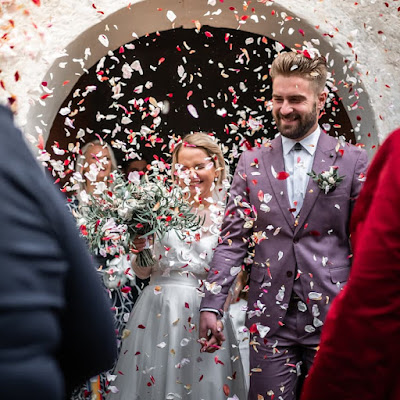The Evolution of Love: Dynamic Trends in Marriage
As we progress further into the 21st century, it's evident
that marriage will continue to adapt to the changing needs and values of
society, reflecting the ongoing pursuit of love, companionship, and shared lives
in ways both familiar and innovative.
The Evolution of Love: Dynamic Trends in Marriage
Love, the cornerstone of human connection, has shaped the
institution of marriage across cultures and time. As societal norms, values,
and perceptions continue to evolve, the dynamics of relationships and the
essence of marriage have undergone significant transformations. From
traditional unions to the contemporary landscape of partnerships, the evolution
of love within marriage reflects a mosaic of dynamic trends in the modern era.

Embracing Change in Relationship Dynamics
The concept of marriage has shifted dramatically, marked by
a notable change in relationship dynamics. Contemporary partnerships are moving
away from the rigid structures of the past, with couples seeking more equitable
and balanced relationships. The evolving roles within marriages reflect a more
collaborative and egalitarian approach, where both partners share
responsibilities, decision-making, and the journey of personal and professional
growth.
Delayed Unions and Changing Priorities
One striking trend in recent years is the delay in entering
into marriage. Millennial and Generation Z individuals are prioritizing
personal growth, education, and career aspirations before committing to
marriage. The focus has shifted from the rush to tie the knot to a more
deliberate and thoughtful approach, emphasizing financial stability,
independence, and emotional maturity before entering into a lifelong
partnership.
Diversity and Inclusivity in Partnerships
The 21st century has witnessed a celebration of diverse partnerships
within the institution of marriage. Society is becoming increasingly accepting
of various forms of relationships, including same-sex marriages, open
marriages, and polyamorous relationships. This increased inclusivity challenges
traditional boundaries, allowing individuals to seek relationships that align
with their personal values and identities.

Technological Influences on Love and Relationships
The advent of technology has revolutionized the way people
form relationships and connect with potential partners. Online dating
platforms, social media, and digital communication have reshaped the dating
landscape, providing a broader and more accessible pool of potential matches.
The ability to connect virtually has transformed courtship, allowing couples to
establish and nurture relationships regardless of geographical boundaries.
Redefining 'Happily Ever After'
The notion of a successful marriage has evolved. The
emphasis is no longer solely on longevity but on the quality and fulfillment of
the relationship. Couples are seeking emotional compatibility, shared values,
and mutual respect as the pillars of a successful partnership. Prioritizing
personal happiness and individual growth within the union has become as crucial
as the traditional aspects of commitment and loyalty.
Rising Rates of Cohabitation
Cohabitation—living together without formal marriage—has
become increasingly prevalent. Many couples opt to test compatibility, share
expenses, or delay marriage by cohabiting before deciding to tie the knot. This
trend has contributed to redefining the societal perception of relationships
and family, allowing individuals to explore the practicalities of life together
before committing to marriage.
Economic and Social Influences
Economic factors continue to influence marriage trends.
Financial stability plays a significant role in the decision to marry,
impacting the timing and nature of unions. Moreover, the societal perception of
marriage has transformed, with an increasing number of individuals prioritizing
personal growth, emotional compatibility, and shared values over solely
economic or social status.

Marriage trends have been shaped by changing perspectives on
gender roles within relationships. Traditional roles, where the husband was the
primary breadwinner and the wife managed household duties, have evolved. Today,
couples are increasingly embracing egalitarian partnerships, where
responsibilities and decision-making are shared more equally between partners.
This shift has impacted the dynamics within marriages, promoting a more
balanced and flexible approach to familial responsibilities.
Diversity in Partnership Forms
The definition of marriage is no longer confined to the
traditional binary concept. The 21st century has seen a surge in diverse
partnership forms. Same-sex marriages, once prohibited or not legally
recognized in various parts of the world, are now legally accepted in many
countries. Additionally, open marriages, polyamorous relationships, and civil
partnerships have gained recognition, challenging the conventional norms of monogamous
unions.

Tech's Influence on Relationships
The digital age has significantly impacted the way people
meet, interact, and form relationships. Online dating platforms and social
media have revolutionized the dating landscape, providing individuals with a
broader pool of potential partners. The ease of connecting virtually has
altered the traditional trajectory of courtship and engagement, leading to an
evolution in the way relationships are initiated and sustained.
A Shift in Age and Timing
One of the noticeable trends in recent years is the changing
age and timing of marriage. Millennials and Generation Z individuals are opting
to delay marriage compared to previous generations. The focus on education,
career aspirations, and financial stability has led many to postpone tying the
knot. Consequently, the average age at first marriage has steadily increased,
highlighting a shift towards later unions.
Conclusion
The evolution of love and marriage reflects the
ever-changing tapestry of human relationships. The modern era witnesses a
departure from conventional norms, fostering more diverse, inclusive, and
flexible definitions of partnerships. The evolving nature of marriage showcases
adaptability, resilience, and the innate desire for love, companionship, and
shared lives.
As society continues to evolve, the trends in marriage
reflect the ongoing pursuit of deep connections and mutual respect. The dynamic
nature of love within marriage invites us to embrace change, celebrate
diversity, and explore the multifaceted expressions of human relationships in
the quest for enduring love and companionship.

.jpg)


Comments
Post a Comment